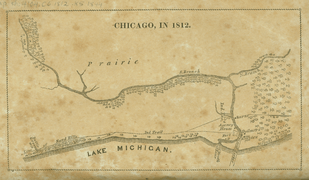Antoine Ouilmette
Antoine Ouilmette (c. 1760–1841) was a fur trader and early resident of what is now Chicago, Illinois. He was of French Canadian and possibly Native American ancestry. The village of Wilmette, Illinois (phonetic spelling of Ouilmette) is named in his honor.[1]
Biography

Little is known about Ouilmette's background and early life. In 1908, amateur historian Frank Grover wrote that previous claims that Ouilmette was an "Indian chief" were false, and that he was instead a white voyageur of French Canadian ancestry.[2] However, "Ouilamette" was a name associated with the Potawatomi tribe decades before Antoine Ouilmette's birth, and so in 1977 anthropologist James A. Clifton speculated that Antoine Ouilmette was "probably a Métis descendant" of Ouilamette, a Native American who was prominent in the Lake Michigan region beginning in the 1680s.[3] Grover wrote that Ouilmette was born in Lahndrayh, near Montréal, in 1760.[4] Another source says that he was baptized as "Antoine Louis Ouimet", on December 26, 1758 in the parish of Sainte-Rose northwest of Montréal, in what is now the city of Laval, Québec. He was the second son of Louis Ouimet dit Albert and Louise Desjardins dit Charbonnier. It is not known why and when Antoine's family name changed to Ouilmette; also referred to as Ouilmet, Houillamette, Willamette, Wilmette, Wilmot, Wemet.[5]
Ouilmette was employed by the American Fur Company,[6] and moved to Chicago in July 1790[7] where he built a log cabin on the north side of the main branch of the Chicago River, just to the west of the property of Jean Baptiste Point du Sable.[5] In 1796 or 1797 he married Archange Marie Chevalier, a French-Potawatomi woman, at Grosse Pointe (now Evanston and Wilmette).[5] He was employed by John Kinzie after Kinzie settled in Chicago in 1804. Ouilmette and his Métis family were friendly with most of the local native American population and so they remained in Chicago in the four years that followed the Battle of Fort Dearborn in 1812. Antoine was the only white resident during this time.[8]
Ouilmette was a "progressive, energetic man of good business ability for those times, he accumulated considerable property. He had a store in Chicago, and also a fine lot of horses, cattle, sheep and hogs. He also had a farm at Racine, Wisconsin, which he frequently visited while living in Chicago. He also made occasional business trips to Milwaukee and Canada." [9]
Antoine and Archange had eight children, four boys and four girls: Joseph, Louis, François, Michel, Elizabeth, Archange, Josette, and Sophia, as well as an adopted daughter, Archange Trombola.[10]
Ouilmette was Roman Catholic. In April 1833, he along with Alexander Robinson, Billy Caldwell, several of the Beaubiens and others, in a petition to the Bishop of the diocese of Missouri, located in St. Louis, asking for permission to establish the first Catholic church in Chicago. The petition was received on 16 April and granted the next day.[11]
In 1829 he was instrumental in persuading local Native Americans to sign the second Treaty of Prairie du Chien; in recognition of this the U.S. government awarded 1,280 acres (5.2 km2) of land in present-day Wilmette and Evanston to Ouilmette's wife Archange and her children. Elijah M. Haines claimed that the land was given to Ouilmette's wife and children as a bribe for Ouilmette's influence in securing the execution of the treaty.[12]
Shortly after this Ouilmette and his family moved to a cabin on this reservation. Ouilmette was also involved with the Treaty of Chicago (1833) negotiations. This treaty not only provided provisions for Chief Robinson and Billy Caldwell, Ouilmette's children, and others but it secured $800 for Ouilmette.[13]
Antoine Ouilmette was "known as a kind, whole souled, generous man of remarkable energy and perseverance, who made friends with everybody, both Indians and whites, and he in turn was universally liked and respected."[14]
According to Grover's book, Benjamin F. Hill, an early Wilmette settler, said that Mr. Joseph Fountain of Evanston and others, were prosecuted by Ouilmette for trespassing and cutting timber. Ouilmette lost the suit and paid a large bill in court costs. Fountain's lawyer sent the sheriff to confiscate and sell two "fine Indian ponies" belonging to Ouilmette, "which were his special pride." It was right after this that the Ouilmette family decided to leave.[15] In 1836 the Potawatomi were relocated west of the Mississippi River and Ouilmette and his family moved with them. He died at Council Bluffs, Iowa on 1 December 1841.[5]
References
- ↑ Stewart, Adam H. "Wilmette, IL". The Electronic Encyclopedia of Chicago. Chicago Historical Society. Retrieved 17 July 2010.
- ↑ Grover, Antoine Ouilmette, pp. 4–5
- ↑ James A. Clifton, The Prairie People: Continuity and Change in Potawatomi Indian Culture 1665–1965 (Lawrence, Kansas: The Regents Press of Kansas, 1977, ISBN 0-7006-0155-4) p. 231.
- ↑ Grover Antoine Ouilmette, p. 4
- 1 2 3 4 "Ouilmette, Antoine Louis". Early Chicago. Early Chicago, Inc. Retrieved 17 July 2010.
- ↑ Currey, Josiah Seymour (1912). Chicago: its history and its builders. Volume II. Chicago: The S.J. Clarke Publishing Company. p. 314.
- ↑ Letter from Antoine Ouilmette to John H. Kinzie dated June 1, 1839, reproduced in Blanchard, Rufus (1898). Discovery and Conquests of the Northwest, with the History of Chicago (volume 1). R. Blanchard and Company. p. 574. Retrieved September 7, 2010.
- ↑ Grover, Antoine Ouilmette, pp. 7–8
- ↑ Grover, Antoine Ouilmette, pp. 25
- ↑ George D. Bushnell. Wilmettee: A History. (Wilmette, Illinois: Wilmette Bicentennial Commission, 1976), 6.
- ↑ Grover, Antoine Ouilmette, pp.9
- ↑ Grover, Antoine Ouilmette, pp.14.
- ↑ Grover, Antoine Ouilmette, pp. 16.
- ↑ Grover, Antoine Ouilmette, pp. 25.
- ↑ Grover, Antoine Ouilmette. and Bushnell, Wilmette: a history, pp. 13.
- Grover, Frank R. (1908). Antoine Ouilmette. Evanston Historical Society. Retrieved September 7, 2010.